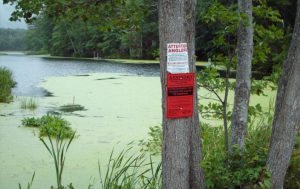Cyanobacteria – Its threat to you and Winnipesaukee!
Join the Lake Winnipesaukee Association on July 25th for an informative talk on the increasing occurrence of cyanobacteria blooms in our lakes and ponds. The talk will be held in the Carriage House, Church Landing at Mill Falls, Meredith, NH, 6:30-8pm. As space is limited pre-registration is required, and can be done online at https://www.eventbrite.com/e/cyanobacteria-its-threat-to-you-and-winnipesaukee-tickets-64385073488
Blooms of potentially toxic cyanobacteria have been happening more frequently around the country and locally in NH. This is a threat not only to human and animal health, but to our local economy as well. Cyanobacteria (often referred to as blue-green algae) are a natural component of New Hampshire waterbodies, and are important organisms for the health and growth of many plants. However, certain cyanobacteria produce toxins that can affect the nervous, liver, and endocrine systems if ingested in large enough quantity.
The evening’s presentation, ‘Cyanobacteria – Its threat to you and Winnipesaukee!’, will feature Dr. James Haney, UNH Professor of Biology, who has been studying the potential impacts of these toxins for decades. The potential human health hazards via exposure through drinking water and/or during recreational water activities are also a concern. Some studies suggest cyanobacteria may be linked to amyotrophic lateral sclerosis (ALS), also known as Lou Gehrig’s disease. Learn about the types of cyanobacteria, current management options, and what you can do to help minimize blooms and keep Winnipesaukee healthy.
The Lake Winnipesaukee Association (LWA) is the leading organization dedicated to keeping Lake Winnipesaukee clean and clear. One of the Association’s goals is to expand the monitoring program to include cyanobacteria monitoring throughout the lake. Another important goal is to begin fixing sites that are contributing pollutants to the lake.
You can help in this effort. Although shorefront property owners are the first line of defense against nutrient loading to the lake, all property owners play a role in keeping the lake clean. Stabilize soil with native plants to avoid erosion. Keep the natural vegetation and buffer along the shoreline. Do not use fertilizers or pesticides on your property. Never rake leaves or dump sand into the lake. Reduce your lawn area. All of these practices will help keep nutrients out of the lake.
If you see an algal bloom or water quality issue, please contact the Lake Winnipesaukee Association at 603-581-6632 or mail@winnipesaukee.org.

